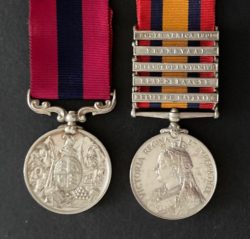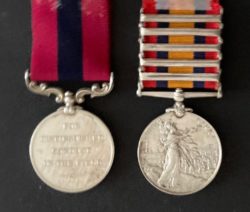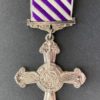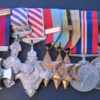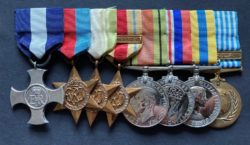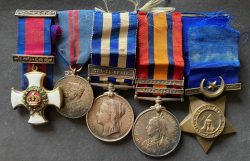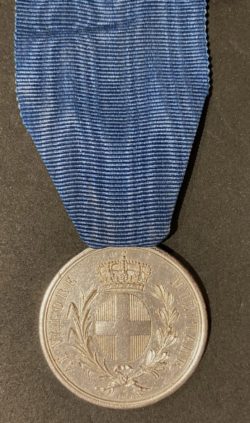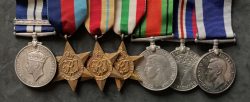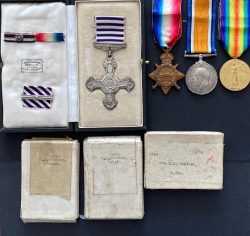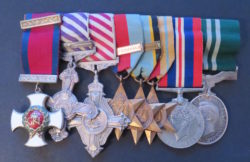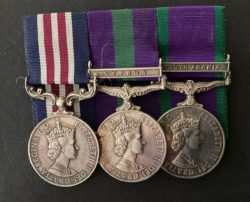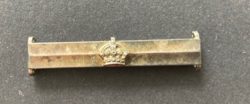D.C.M. (VR) Q.S.A. Relief of Mafeking, Elandslaagte, Defence of Ladysmith. Sq. Sergeant Major 5th Drag. Gds & Regimental Sergeant Major. Imperial L.H. Exceptional posthumous award for Hartbeestfontein 22/3/1901, where the recipient was killed in action , a rearguard action later described by the Boer leader Smuts as ‘the most brilliant one I had seen fought by either side during the entire campaign. Both General de la Rey and myself were determined to capture the pom-pom, as well as the ILH” . Additionally commended for Cyferfontein where the ILH came under close range, withering fire from a far numerically superior Boer force, and with mounting casualties with his charger shot in several places and his uniform and saddlery shot though in many places galloped up and down the whole line of ILH, hat in hand, waving the men away, shouting the order: “Retire! Retire!”
£5,200.00
1 in stock
D.C.M. (VR – Sqdn. Sgt. Major 5th Drag. Gds) Q.S.A. Relief of Mafeking, Elandslaagte, Defence of Ladysmith. , Tr., S.A.1901 (Sqdn. Sgt. Major 5th Drag. Gds)
Sq: S. Major A. Hurst, 5th Dragoon Guards (Hirst on DCM).
Mentioned in despatches L.G. 9/7/1901, commended by General Babingtonm included within Kitchener’s recommendations for. Vaal Bank of the 24th and remarks ‘Awarded D.C.M. Authority War Office telegram dated 23 April 1901.
Arthur E. Hurst born Chester, (alias Hayes) enl. 1885 occupation stated as Engineer, was serving in South Africa with his parent unit when the war broke out and saw action at Elandslaagte and during the Defence of Ladysmith. He was one of 3 Sergeants transferred in from the 5th Dragoon Guards by Major B R M Glossop when Adjutant of the 1st Imperial Light Horse and he earned his Relief of Mafeking, Transvaal and SA1901 clasps with his adopted unit.
Action of Cyferfontein, 5 January, 1901
Extracted from “The Story of the Imperial Light Horse” by Lt G F Gibson and ‘A History of the British Cavalry volume 4, 1899-1913.
As Babington’s force marched northwest, numbers of Boers were sighted off to the British left, moving from one hill to another on a farm called Cyferfontein, and the Major-General ordered Woolls-Sampson to chase them off. Always eager to get at his hated foe, Woolls-Sampson neglected to dispatch any scouts, and instead led his two squadrons off at a ‘fast trot’ towards the Boer-held hills. So rapid was the advance of the ILH, indeed, that a pair of attached pom-poms under Captain Brierley R.A. , were unable to keep up, and soon fell behind.
‘Briggs twice cautioned the impetuous Woolls-Sampson to slow down, and send scouts forwards, but ‘Sambo’ (Woolls-Samson) was having none of it; even when he was finally persuaded to deploy scouts, he pressed his troops forward so close behind them as to defeat their purpose. De la Rey had rushed about 700-800 Boers to the hill closest to the British column, and they lay hidden in the long grass on the hill top. These suddenly opened fire on the on-coming ILH at only about 50-100 yards. Fortunately, Briggs had already deployed his squadron (‘C’), but Woolls-Sampson’s ‘B’ Squadron took the full brunt of the ambush. True to form, however, the gallant Lighthorsemen ‘behaved magnificently’ and were ‘wonderfully steady’:’
‘Those who survived the first volley dismounted , their panic stricken horses plunging madly, and returned their fire. They could see little, however, of their foes, who kept well down in the long grass. Many of the surviving men took cover and fired from behind their dead horses; others, to get a better target, knelt, returning the fire in that position, a number of them had the tops of their heads shot off’.
The indomitable Woolls-Sampson remained mounted throughout, utterly disregarding the fusillade as he shouted and encouraged his men. After ten minutes of hell, even Woolls-Sampson bowed to the inevitable and realising that the situation was hopeless screamed “Retire! Retire” The Boers now, according to an officer who was present, galloped down between the two squadrons firing from the saddle.’
‘Regimental Sergeant Major Hurst (attached to the ILH from the 5th Dragoon Guards) also ignored the flying lead, galloping up and down the whole line of ILH, hat in hand, waving the men away, shouting the order: “Retire! Retire!”. ‘
‘As the lighthorsemen withdrew towards the pom-poms (which had by then caught up), a ‘much agitated’ Woolls-Sampson ordered Captain Brierley to withdraw his guns at the gallop. Before this could be done, however, Major Briggs (‘unperturbed and less excitable than the Colonel’), rode up and countermanded the order. Brierley reported to Briggs: “I know where the Boers are, but they do not know where I am. I propose to come into action, notwithstanding my orders from the Colonel to retire”. Briggs immediately agreed and the guns were moved forwards to a better position. Thanks to the quick thinking of Brierley and Briggs (who each took personal command of a pom-pom), when De la Rey’s horsemen rode into view round the lower western slopes of the hill, clearly moving to attack Babington’s rear:’
‘Both pom-poms opened rapid fire at a range of 800 yards, firing 300 rounds, completely defeating the enemy movement. This sharp bombardment – together with a move against his flanks by the balance of Babington’s mounted troops (under Colonel Raleigh Grey[ix]) – was too much for De la Rey, and he withdrew his Commando, galloping back up the valley. Grey’s troopers pursued the fleeing Boers, but the broken country quickly rendered this ineffective.’
‘Though De la Rey’s men had fled the field, they had nevertheless had much the better of the day. The bodies of just four dead Boers were found, and it was later discovered that another 14 had been wounded in the action. In contrast, the ill-considered rush of the Imperial Light Horse had cost the regiment 18 men killed and 32 wounded, overwhelmingly from ‘B’ Squadron.’
it is related that during the action at Cyferfontein on 5 Jan 1901, ‘Miraculously neither Colonel Wools-Sampson, Major Briggs, Captain Normand nor RSM Hurst, although remaining mounted were touched, but their chargers were wounded in many places and their saddlery and clothing were pierced by many bullets.’
Hurst displayed much coolness under fire that day, but, as the history of the ILH records an exchange with a visiting member of the Army Service Corps that evening:
‘Hurst was yarning to the members of his mess, including a visiting Sergeant-Major of the A.S.C., about the day’s experiences; he was particularly sore about the damage to his hat, which had received more than its arithmetical quota of attention from the enemy that morning, no less than three bullets having torn through it and shot it to rags. His miraculous escape from death concerned him less, knowing the workings of the supply side, than the prospect of having to replace the hat at his own expense. Sourly regarding his wrecked headgear, he commented fluently upon the parentage, upbringing and morals of the “New Hat Department.” The Sergeant-Major from the A.S.C., his branch of the Service involved, imprudently intervened: “What would happen if every soldier wanting a new hat merely fired three bullets through his old one and then claimed a new one?” At this interjection (and possible innuendo) Hurst warmed to his work in real earnestness. Expurgated of his Rabelaisian ornamentation and the choicer cuts and thrusts of army lingo and shafts of pious wit (this out of consideration for our more gently nurtured readers) his homily on the scale of values, rank and precedence in the army, but nothing about ‘hats’ ran:- “Look here, my lad (glaring maliciously). You are talking to the R.S.M. of the I.L.H., and a S.M. of the 5th Dragoon Guards, two fighting regiments, FIGHTING regiments. My Colonel, if he knew that I, a cavalry soldier, had condescended to argue with one, do you know what he’d do? Of course, you don’t – pity the ignorant! He’d have me on the peg and reduced to the ranks in a brace of shakes. Now, no more ruddy talk from YOU about my hat.”
Arthur Hurst was killed in action at Hartebeestfontein. 22/3/1901.
General Babbington’s operations over three days being the action of Hartbeestfontein, 22/3/1901 to tother with the subsequent actions of the 23rd & 24th capture of the Boer guns at Vaal Bank. Hurst’s recommendation is included within the recommendations covering the three days of operations but is specific to the first day.
From ‘A History of the British Cavalry volume 4, 1899-1913.
‘At Geduld Farm, near Haartebeestfontein , in the western Traansvaal, on 22 March, 1901, 175 of Brigg’s men (ILH), with one Maxim, were on reconnaissance when some 400 of General Jacobus de la Rey’s burghers charged down on them. This was the second occasion in the war on which the Boers employed their new tactic of charging in close formation. They looked according to an eye-witness, as they galloped over open ground, ‘like a cavalry brigade in mass’. The ILH were all dismounted in a thin, extending line, but most of them speedily regained their horses . “ We were all ordered to retire,” wrote Captain Patrick Hill Normand, “squadron by squadron , covering one another”. Thus slowly but skilfully, pressed hard for over four miles. To the security of their mountain camp. From there the enemy was forced to retreat by heavy shelling.’
General Jan Smuts, whose Commando was part of De la Rey’s force said later ‘The rearguard action bought by the ILH was the most brilliant one I had seen fought by either side during the entire campaign. Both General de la Rey and myself were determined to capture the pom-pom, as well as the ILH” .
RSM. Hurst is commemorated on the Imperial Light Horse Monument at Haartebeesfontein (as RSM. Hirst) ’Tell England, ye that pass this monument, that we, who died serving her, rest here content’.
A superlative DCM pair. and a rare QSA combination to a British recipient.
